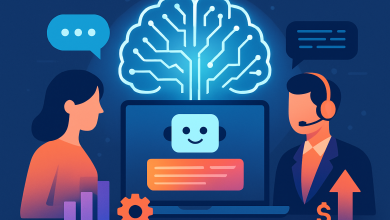
Despite the buzz around AI in retail, many shoppers are still on the fence. The three core reasons shoppers are hesitant to use AI shopping assistants: they don’t see the need, simply prefer human help or are concerned about privacy/data security. But as major industry players continue rewriting the rules of UX for AI-assisted shopping, making it more embedded and intuitive in the buyer journey, what feels foreign today is fast becoming tomorrow’s norm. Soon, the sentiment around AI-assisted shopping will shift from skepticism to everyday expectation. And retailers need to embed intelligence into their digital commerce experience to stay ahead.

AI Shopping is Getting Smarter & Quieter
Many retailers are investing in AI to enhance shopping across channels—reshaping both backend operations and consumer-facing experiences. Statista revealed that customer service was the leading use case for AI among ecommerce businesses, with 61% opting for chatbots; the global AI for customer service market was estimated to be $13 billion in 2024 and is expected to reach $84 billion by 2033. But Prosper Insights and Analytics revealed in Forbes that over 70% of American shoppers 18+ would prefer to speak to a live sales associate rather than an AI bot, suggesting retailers may have jumped the gun regarding AI chatbots.
So what do shoppers want? Speed, simplicity and confidence. AI has been quietly delivering on all three, becoming the backbone of modern commerce, not through bots but through embedded predictive infrastructure that shifts how brands approach customer experience, operational efficiency and personalization at scale.
Behind the scenes, AI has been influencing the buyer journey for shoppers in the research phase—think tailored product feeds, predictive search and recommendations based on browsing history. As generative AI becomes less of a novelty and more of a silent engine behind digital experiences, the paradigm is shifting. When it’s so seamlessly integrated into the shopping journey, customers don’t even realize they’re interacting with it. And maybe that’s the key to shifting consumer sentiment around AI from skepticism to trust: frictionless use cases that quietly (and accurately) get the job done.

The Rise of Embedded AI in Retail: Rethinking UX, Trust and Personalization
For brands and retailers, the opportunity for AI-assisted shopping isn’t in building technology that looks futuristic—it’s in deploying AI that feels natural, builds trust and delivers measurable impact without disrupting the user experience.
The biggest names in AI and commerce have leaned into this shift by redefining UX and hyper-personalization with a streamlined, end-to-end approach. OpenAI’s latest partnerships with Salesforce, Stripe, Etsy and Shopify mark a significant advancement in the AI for shopping space; Instant Checkout is turning the popular ChatGPT program into a storefront, seamlessly closing the loop with a shopping experience that simplifies the buyer journey from research to purchase. No redirects. Just intent, met instantly, personalized to the user’s conversation with Chat.
While the general population is curious but hesitant toward AI-powered shopping, this UX upgrade may fundamentally shift how consumers view AI-assisted shopping experiences. By turning ChatGPT into a fully shoppable interface—powered by trusted platforms like Salesforce’s Enterprise Work and Commerce arms, Stripe, Etsy and Shopify—OpenAI is seamlessly bringing AI shopping to over 700 million users per week. On a mission to meet customers where they are, these partnerships empower merchants to offer seamless, secure transactions and capture demand when shoppers search for products—while keeping full control of their processes, data and customer relationships.
AI is No Longer a Feature—It’s the Foundation of Modern Shopping
As generative AI becomes more embedded across commerce platforms, retailers are shifting from chatbot-based experiences to full-scale, AI-driven infrastructure. What was once experimental will become essential. AI is quietly redefining digital UX; the next evolution of AI in retail won’t be about bots replacing associates—it’ll be about intelligence embedded so deeply into the user experience that it becomes invisible.
As systems get smarter, more contextual and better aligned with consumer behavior, hesitation will give way to habit. For retailers, the challenge now isn’t to prove the value of AI, but to design it so seamlessly that shoppers never have to think twice.




